jump start BMW X5 3.0I 2003 Owners Manual
[x] Cancel search | Manufacturer: BMW, Model Year: 2003, Model line: X5 3.0I, Model: BMW X5 3.0I 2003Pages: 183, PDF Size: 2.31 MB
Page 6 of 183
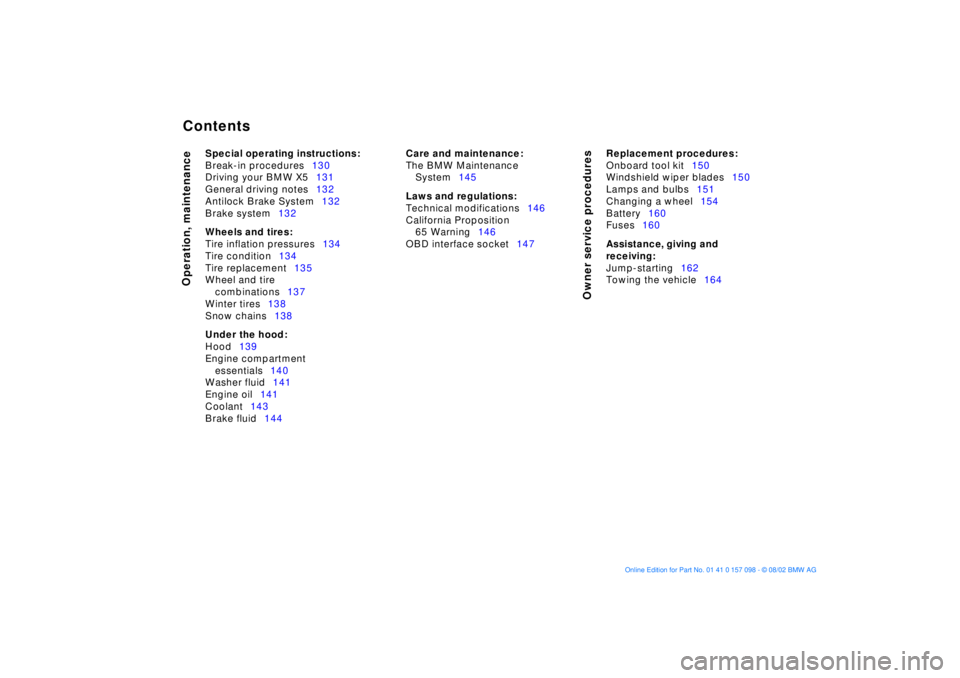
Contents
Operation, maintenance
Owner service procedures
Special operating instructions:
Break-in procedures130
Driving your BMW X5131
General driving notes132
Antilock Brake System132
Brake system132
Wheels and tires:
Tire inflation pressures134
Tire condition134
Tire replacement135
Wheel and tire
combinations137
Winter tires138
Snow chains138
Under the hood:
Hood139
Engine compartment
essentials140
Washer fluid141
Engine oil141
Coolant143
Brake fluid144
Care and maintenance:
The BMW Maintenance
System145
Laws and regulations:
Technical modifications146
California Proposition
65 Warning146
OBD interface socket147
Replacement procedures:
Onboard tool kit150
Windshield wiper blades150
Lamps and bulbs151
Changing a wheel154
Battery160
Fuses160
Assistance, giving and
receiving:
Jump-starting162
Towing the vehicle164
Page 23 of 183
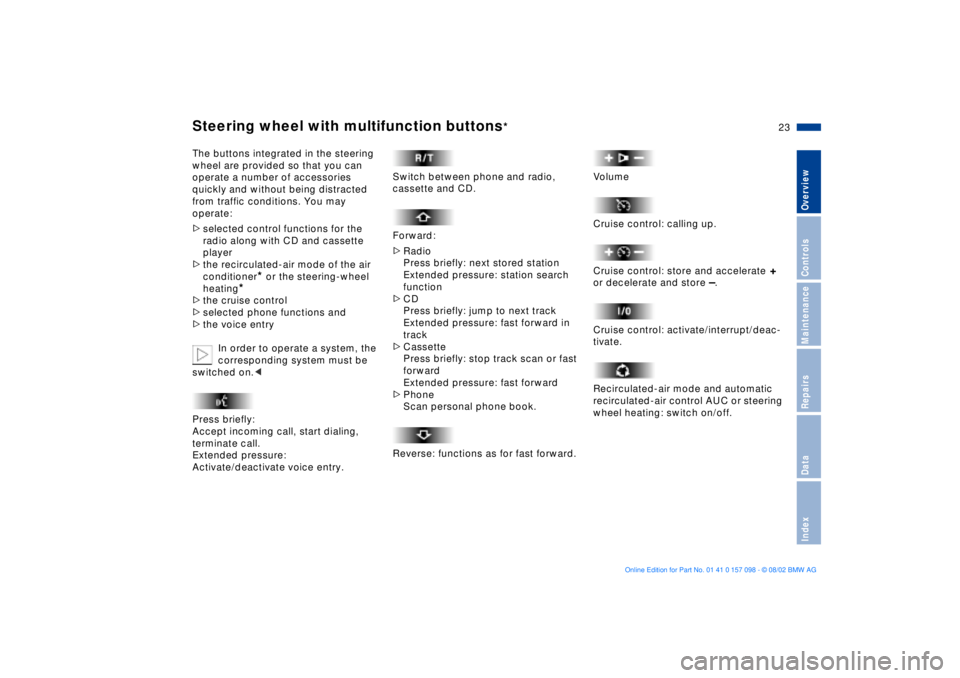
23n
OverviewControlsMaintenanceRepairsDataIndex
Steering wheel with multifunction buttons
*
The buttons integrated in the steering
wheel are provided so that you can
operate a number of accessories
quickly and without being distracted
from traffic conditions. You may
operate:
>selected control functions for the
radio along with CD and cassette
player
>the recirculated-air mode of the air
conditioner
* or the steering-wheel
heating
*
>the cruise control
>selected phone functions and
>the voice entry
In order to operate a system, the
corresponding system must be
switched on.<
Press briefly:
Accept incoming call, start dialing,
terminate call.
Extended pressure:
Activate/deactivate voice entry.
Switch between phone and radio,
cassette and CD.
Forward:
>Radio
Press briefly: next stored station
Extended pressure: station search
function
>CD
Press briefly: jump to next track
Extended pressure: fast forward in
track
>Cassette
Press briefly: stop track scan or fast
forward
Extended pressure: fast forward
>Phone
Scan personal phone book.
Reverse: functions as for fast forward.
Volume
Cruise control: calling up.
Cruise control: store and accelerate
+
or decelerate and store
Ð.
Cruise control: activate/interrupt/deac-
tivate.
Recirculated-air mode and automatic
recirculated-air control AUC or steering
wheel heating: switch on/off.
Page 63 of 183

63n
OverviewControlsMaintenanceRepairsDataIndex
Starting the engine Switching off the engineDo not press the accelerator pedal
while starting the engine.
BMW X5 3.0i:
Do not actuate the starter for too
short a time. Do not turn it for more
than approx. 20 seconds. Release the
ignition key immediately as soon as the
engine starts.
BMW X5 4.4i, 4.6is:
Your BMW is equipped with the conve-
nience starting feature. Simply turn the
ignition key to position 3 Ð starter Ð and
then release it immediately.
The starter actuation continues to
operate automatically for a certain
period of time and is stopped automati-
cally as soon as the engine has started.
The automatic starting mode will not
operate if the battery voltage is low.
The engine can be started by means of
jump-starting, refer to page 162.<
Do not allow the engine to warm up
by leaving it running while the vehicle
remains stationary. Instead, begin to
drive immediately at a moderate engine
speed.
Should the engine fail to start on the
first attempt, if it is very hot or cold, for
instance:
>Press the accelerator pedal halfway
down while engaging the starter.
Cold starts at altitudes above 3,300 ft/
1,000 meters and at very low tempera-
tures, from approx. +5 7/Ð15 6:
>For the initial start attempt, allow the
starter to remain engaged somewhat
longer, approx. 10 seconds.
Engine idle speed is controlled by the
engine computer system. Increased
speeds at start-up are normal and
should decrease as the engine warms
up. If engine speed does not decrease,
service is required.
To prevent the battery from discharging,
always switch off electrical devices that
are not in use. Switch the ignition off
when the vehicle is not being driven.
Extended starting attempts, char-
acterized by excessively frequent
or long periods with the starter
engaged, can lead to damage of the
catalytic converter.<
Turn the ignition key to position 1 or 0.
Do not remove the ignition key
while the vehicle is still moving. If
you do so, the steering will lock.
Always remove the ignition key and
engage the steering lock before leaving
the vehicle.
Vehicles with manual transmission:
Always engage the parking brake when
parking on slopes and inclined sur-
faces. Even placing the gearshift lever
in 1st gear or reverse may not provide
adequate resistance to rolling.
Vehicles with automatic transmission:
Place the selector lever in Park.<
Vehicles with automatic transmission:
The vehicle must be stationary and the
selector lever in Park before you can
remove the ignition key.
Page 67 of 183
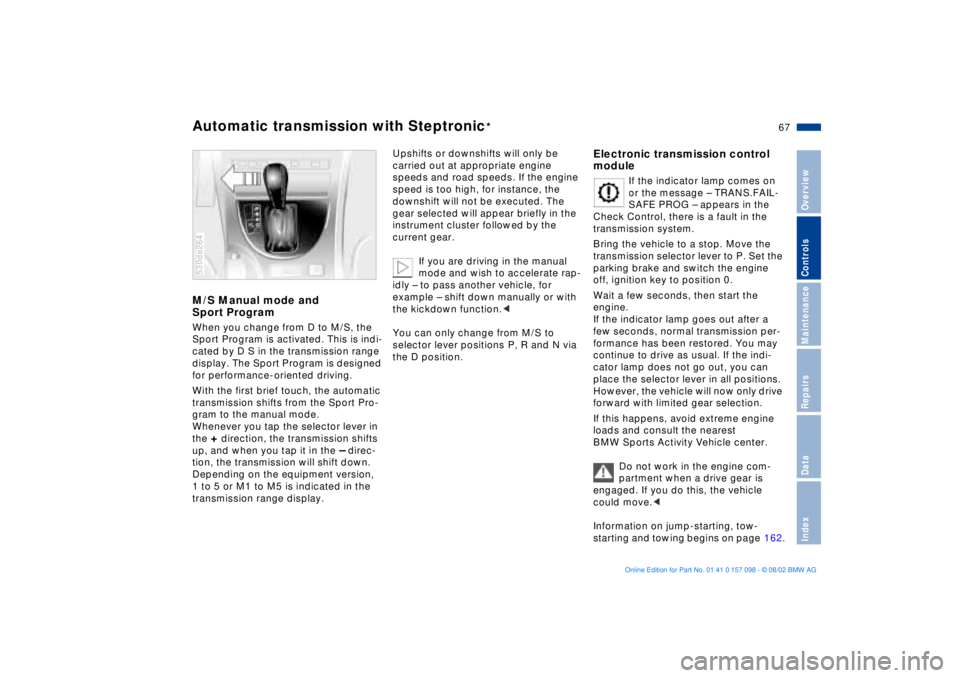
67n
OverviewControlsMaintenanceRepairsDataIndex
Automatic transmission with Steptronic
*
M/S Manual mode and
Sport Program When you change from D to M/S, the
Sport Program is activated. This is indi-
cated by D S in the transmission range
display. The Sport Program is designed
for performance-oriented driving.
With the first brief touch, the automatic
transmission shifts from the Sport Pro-
gram to the manual mode.
Whenever you tap the selector lever in
the
+ direction, the transmission shifts
up, and when you tap it in the
Ð direc-
tion, the transmission will shift down.
Depending on the equipment version,
1 to 5 or M1 to M5 is indicated in the
transmission range display.
530de264
Upshifts or downshifts will only be
carried out at appropriate engine
speeds and road speeds. If the engine
speed is too high, for instance, the
downshift will not be executed. The
gear selected will appear briefly in the
instrument cluster followed by the
current gear.
If you are driving in the manual
mode and wish to accelerate rap-
idly Ð to pass another vehicle, for
example Ð shift down manually or with
the kickdown function.<
You can only change from M/S to
selector lever positions P, R and N via
the D position.
Electronic transmission control
module
If the indicator lamp comes on
or the message Ð TRANS.FAIL-
SAFE PROG Ð appears in the
Check Control, there is a fault in the
transmission system.
Bring the vehicle to a stop. Move the
transmission selector lever to P. Set the
parking brake and switch the engine
off, ignition key to position 0.
Wait a few seconds, then start the
engine.
If the indicator lamp goes out after a
few seconds, normal transmission per-
formance has been restored. You may
continue to drive as usual. If the indi-
cator lamp does not go out, you can
place the selector lever in all positions.
However, the vehicle will now only drive
forward with limited gear selection.
If this happens, avoid extreme engine
loads and consult the nearest
BMW Sports Activity Vehicle center.
Do not work in the engine com-
partment when a drive gear is
engaged. If you do this, the vehicle
could move.<
Information on jump-starting, tow-
starting and towing begins on page 162.
Page 108 of 183

108n
Automatic climate control
*
Air conditioning
The air is cooled and
dehumidified and Ñ
depending on the temperature setting Ñ
warmed again. Depending on the
weather, the windshield may fog over
briefly when the engine is started. You
can reduce condensation forming on
the windows by switching on the air
conditioning.
During air conditioning condensa-
tion forms, which then exits under
the vehicle. Traces of condensed water
of this kind are thus normal.<
Maximum cooling
You will get maximum
cooling capacity using this
program if the engine is running and
the outside temperature is above
approx. +41 7/+5 6.
The temperature display 9 jumps to
+60 7/+16 6, the system switches
over to the recirculated-air mode, and
the air streams out of the ventilation grill
with the maximum air supply. That is
why you need to keep these open if you
select this program.
Automatic recirculated-air
control AUC
If there are unpleasant
odors or pollutants in the
outside air, you can temporarily block
the air supply from the outside. The
system then recirculates the air
currently within the vehicle. Press the
button repeatedly to run through the
following control sequence
>Indicator lamps off: outside air supply
operational
>Left-hand indicator lamp on Ð AUC
mode: the system recognizes pollut-
ants in the outside air and blocks the
flow of air when necessary. The
system then recirculates the air
currently within the vehicle.
Depending on the air quality, the
automatic system then switches back
and forth between outside air supply
and recirculation of the air within the
vehicle
>Right-hand indicator lamp on: the
outside air supply into the vehicle is
completely blocked. The system then
recirculates the air currently within
the vehicle.
If you have a steering wheel with multi-
function buttons with the button for
recirculated-air mode, refer to page 23,
you can also use this button to switch
between Off and the recirculated-air
mode or AUC and the recirculated-air
mode.
If the windows fog over in the
recirculated-air mode, switch the
recirculated-air mode off and increase
the air supply as required.< Rear window defroster
When the rear window
defroster is activated,
the indicator lamp comes on. The
rear window defroster switches off
automatically.
Page 140 of 183
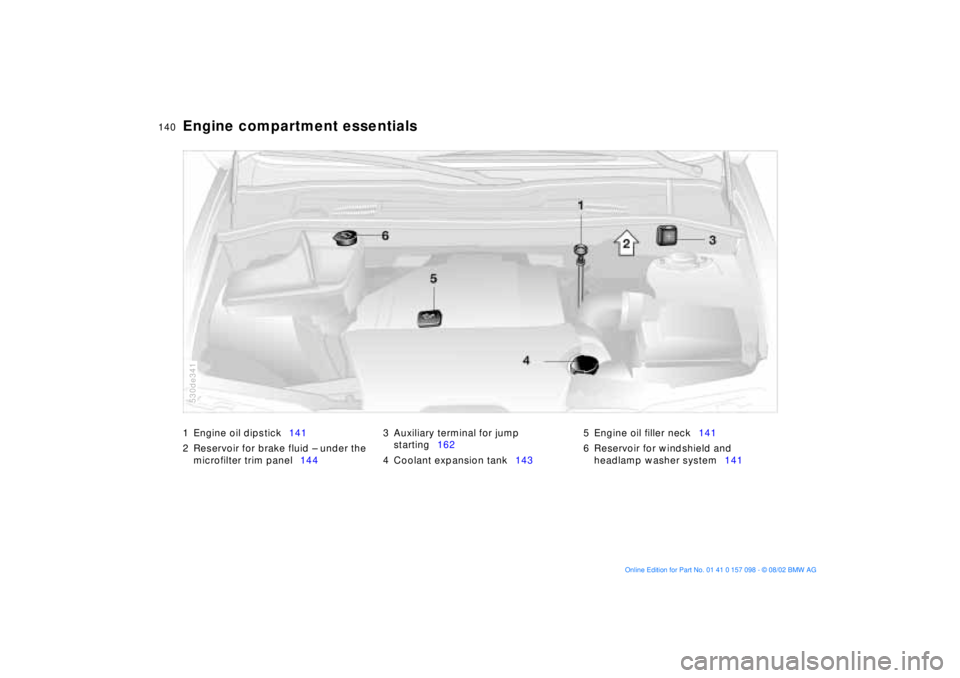
140n
1 Engine oil dipstick141
2 Reservoir for brake fluid Ð under the
microfilter trim panel144 3 Auxiliary terminal for jump
starting162
4 Coolant expansion tank1435 Engine oil filler neck141
6 Reservoir for windshield and
headlamp washer system141
Engine compartment essentials
530de341
Page 160 of 183

160n
Battery Fuses
Battery posts, terminals and
related accessories contain lead
and lead compounds. Wash hands after
handling.<
MaintenanceThe battery is maintenance-free, that is,
the original electrolyte will normally last
for the service life of the battery under
moderate climatic conditions.
For all questions that regard the
battery, please consult your
BMW Sports Activity Vehicle center.
Since the battery is maintenance-free,
the following is for your information
only.<
Do not disconnect the battery
when the engine is running. If
you do so, the ensuing voltage surge
will damage the vehicle's onboard elec-
tronics.<
Charging the battery Charge the battery in the vehicle only
when the engine is not running. Use the
connections provided in the engine
compartment. For correct connections,
refer to Jump-starting on page 162. Disposal
Return used batteries to a recyc-
ling point or your BMW Sports
Activity Vehicle center. Maintain the
battery in an upright position for trans-
port and storage. Secure the battery
against tilting during transport.<
In the glove compartmentOpen the glove compartment and turn
the two quick-release fasteners to the
left. 530us121
Page 162 of 183
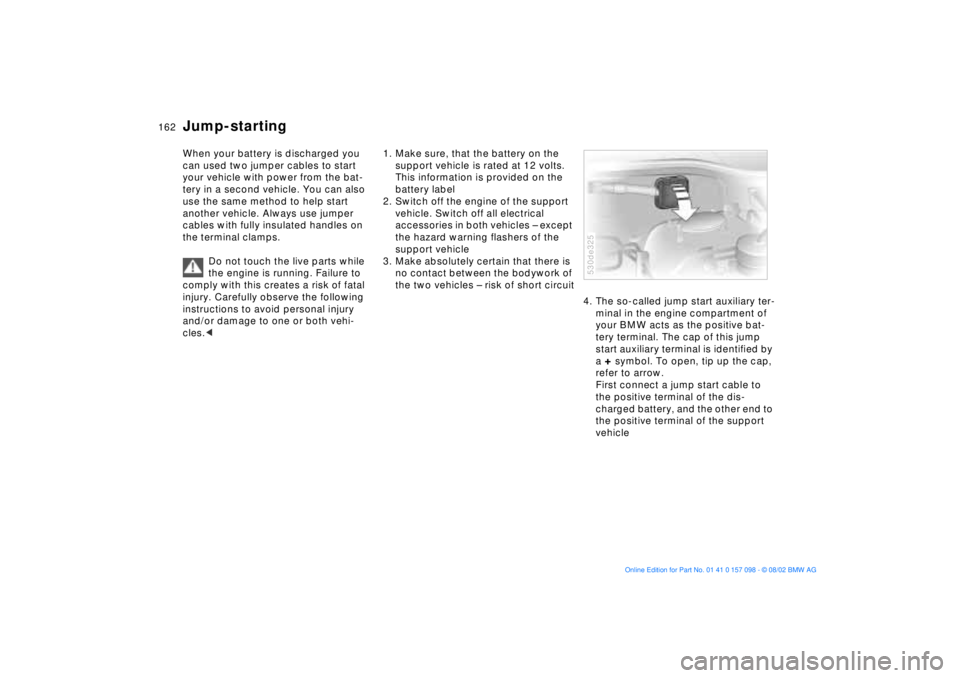
162n
When your battery is discharged you
can used two jumper cables to start
your vehicle with power from the bat-
tery in a second vehicle. You can also
use the same method to help start
another vehicle. Always use jumper
cables with fully insulated handles on
the terminal clamps.
Do not touch the live parts while
the engine is running. Failure to
comply with this creates a risk of fatal
injury. Carefully observe the following
instructions to avoid personal injury
and/or damage to one or both vehi-
cles.<
1. Make sure, that the battery on the
support vehicle is rated at 12 volts.
This information is provided on the
battery label
2. Switch off the engine of the support
vehicle. Switch off all electrical
accessories in both vehicles Ð except
the hazard warning flashers of the
support vehicle
3. Make absolutely certain that there is
no contact between the bodywork of
the two vehicles Ð risk of short circuit
4. The so-called jump start auxiliary ter-
minal in the engine compartment of
your BMW acts as the positive bat-
tery terminal. The cap of this jump
start auxiliary terminal is identified by
a
+ symbol. To open, tip up the cap,
refer to arrow.
First connect a jump start cable to
the positive terminal of the dis-
charged battery, and the other end to
the positive terminal of the support
vehicle
530de325
Jump-starting
Page 163 of 183
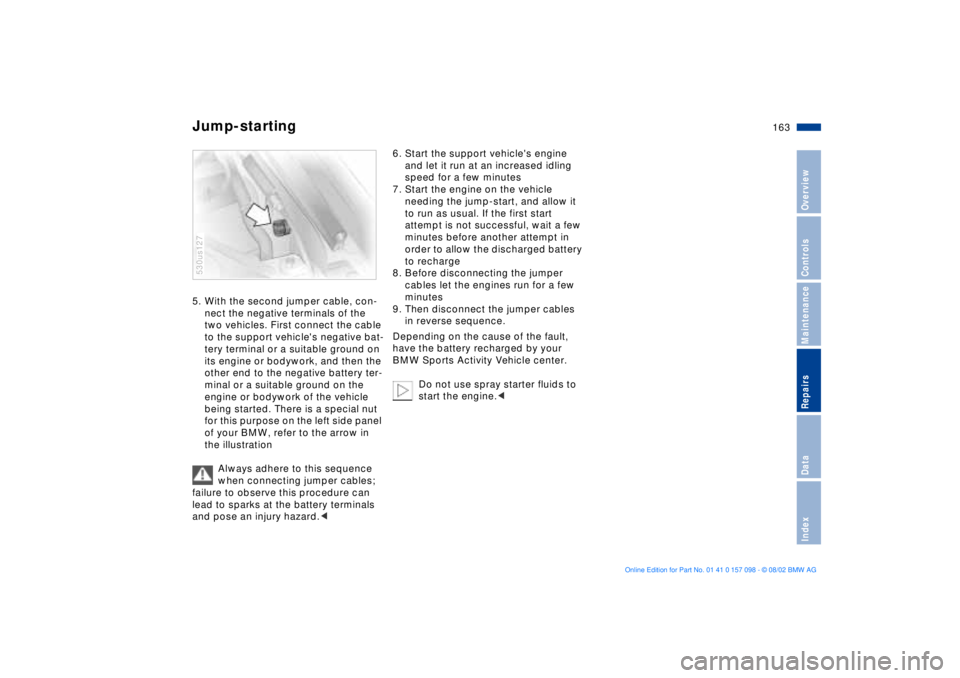
163n
OverviewControlsMaintenanceRepairsDataIndex
Jump-starting 5. With the second jumper cable, con-
nect the negative terminals of the
two vehicles. First connect the cable
to the support vehicle's negative bat-
tery terminal or a suitable ground on
its engine or bodywork, and then the
other end to the negative battery ter-
minal or a suitable ground on the
engine or bodywork of the vehicle
being started. There is a special nut
for this purpose on the left side panel
of your BMW, refer to the arrow in
the illustration
Always adhere to this sequence
when connecting jumper cables;
failure to observe this procedure can
lead to sparks at the battery terminals
and pose an injury hazard.< 530us127
6. Start the support vehicle's engine
and let it run at an increased idling
speed for a few minutes
7. Start the engine on the vehicle
needing the jump-start, and allow it
to run as usual. If the first start
attempt is not successful, wait a few
minutes before another attempt in
order to allow the discharged battery
to recharge
8. Before disconnecting the jumper
cables let the engines run for a few
minutes
9. Then disconnect the jumper cables
in reverse sequence.
Depending on the cause of the fault,
have the battery recharged by your
BMW Sports Activity Vehicle center.
Do not use spray starter fluids to
start the engine.<
Page 164 of 183
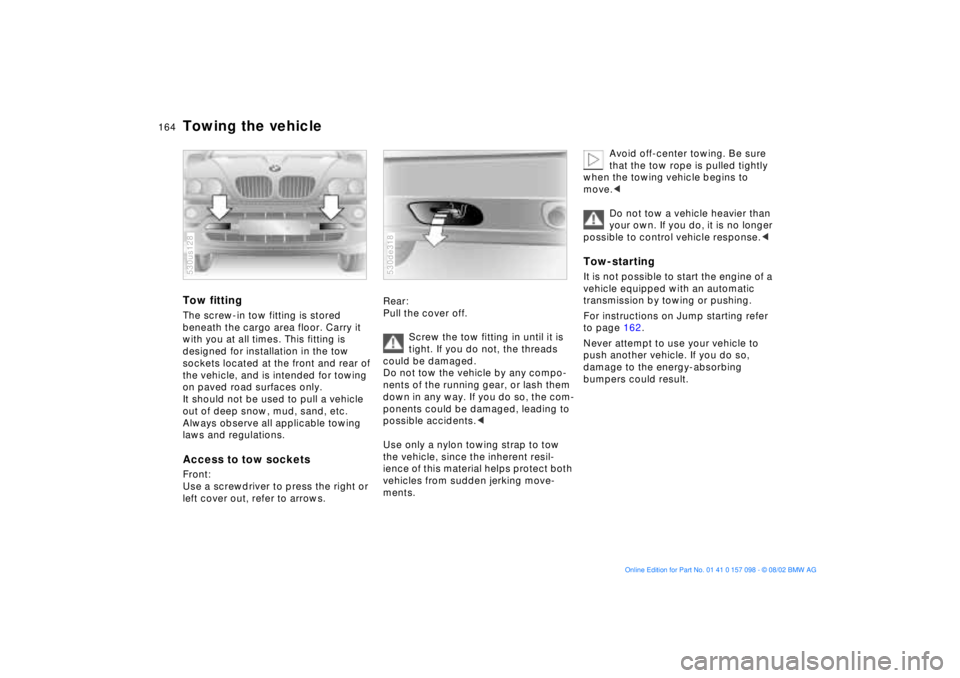
164n
Towing the vehicle Tow fittingThe screw-in tow fitting is stored
beneath the cargo area floor. Carry it
with you at all times. This fitting is
designed for installation in the tow
sockets located at the front and rear of
the vehicle, and is intended for towing
on paved road surfaces only.
It should not be used to pull a vehicle
out of deep snow, mud, sand, etc.
Always observe all applicable towing
laws and regulations. Access to tow sockets Front:
Use a screwdriver to press the right or
left cover out, refer to arrows.530us128
Rear:
Pull the cover off.
Screw the tow fitting in until it is
tight. If you do not, the threads
could be damaged.
Do not tow the vehicle by any compo-
nents of the running gear, or lash them
down in any way. If you do so, the com-
ponents could be damaged, leading to
possible accidents.<
Use only a nylon towing strap to tow
the vehicle, since the inherent resil-
ience of this material helps protect both
vehicles from sudden jerking move-
ments. 530de318
Avoid off-center towing. Be sure
that the tow rope is pulled tightly
when the towing vehicle begins to
move.<
Do not tow a vehicle heavier than
your own. If you do, it is no longer
possible to control vehicle response.<
Tow-startingIt is not possible to start the engine of a
vehicle equipped with an automatic
transmission by towing or pushing.
For instructions on Jump starting refer
to page 162.
Never attempt to use your vehicle to
push another vehicle. If you do so,
damage to the energy-absorbing
bumpers could result.